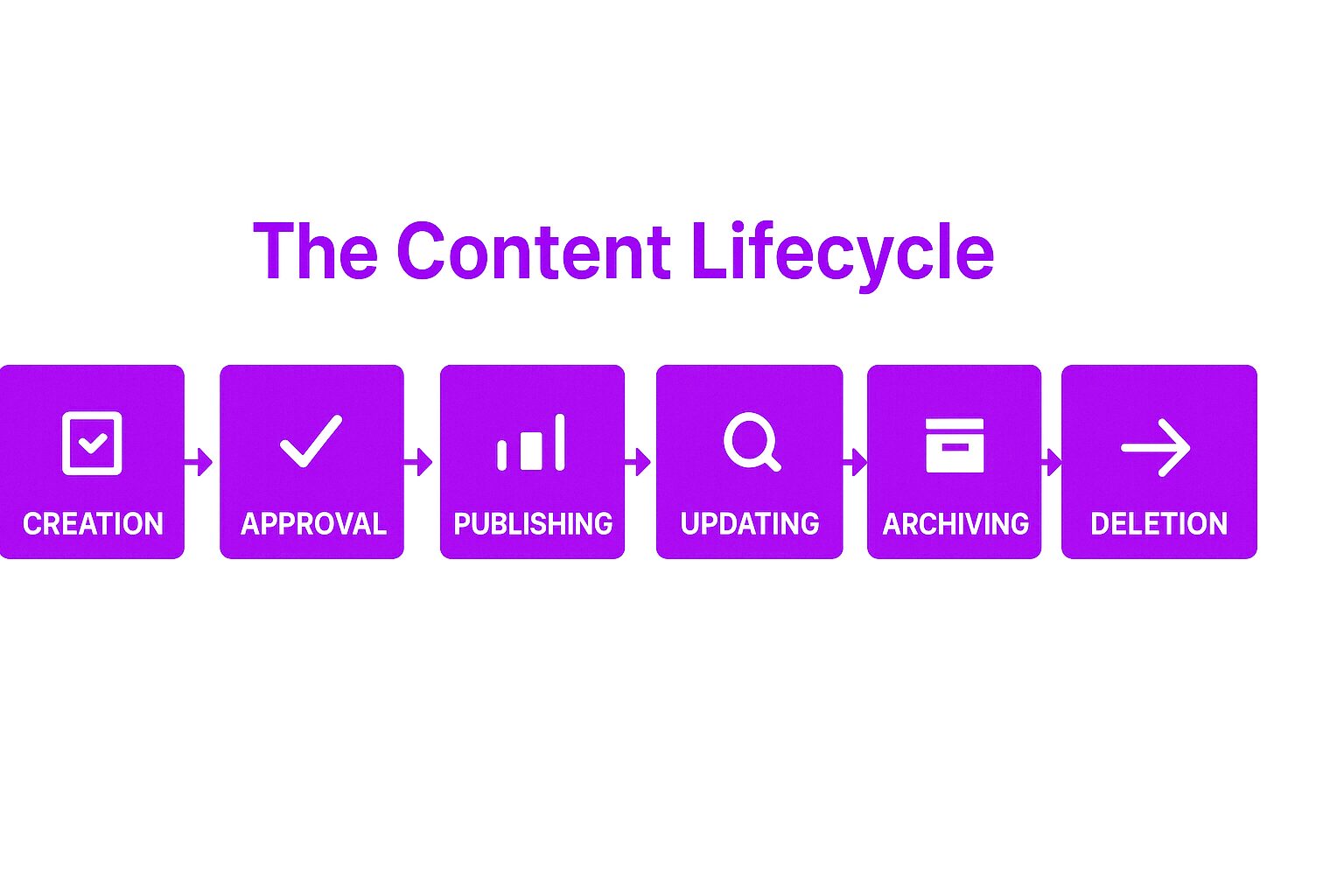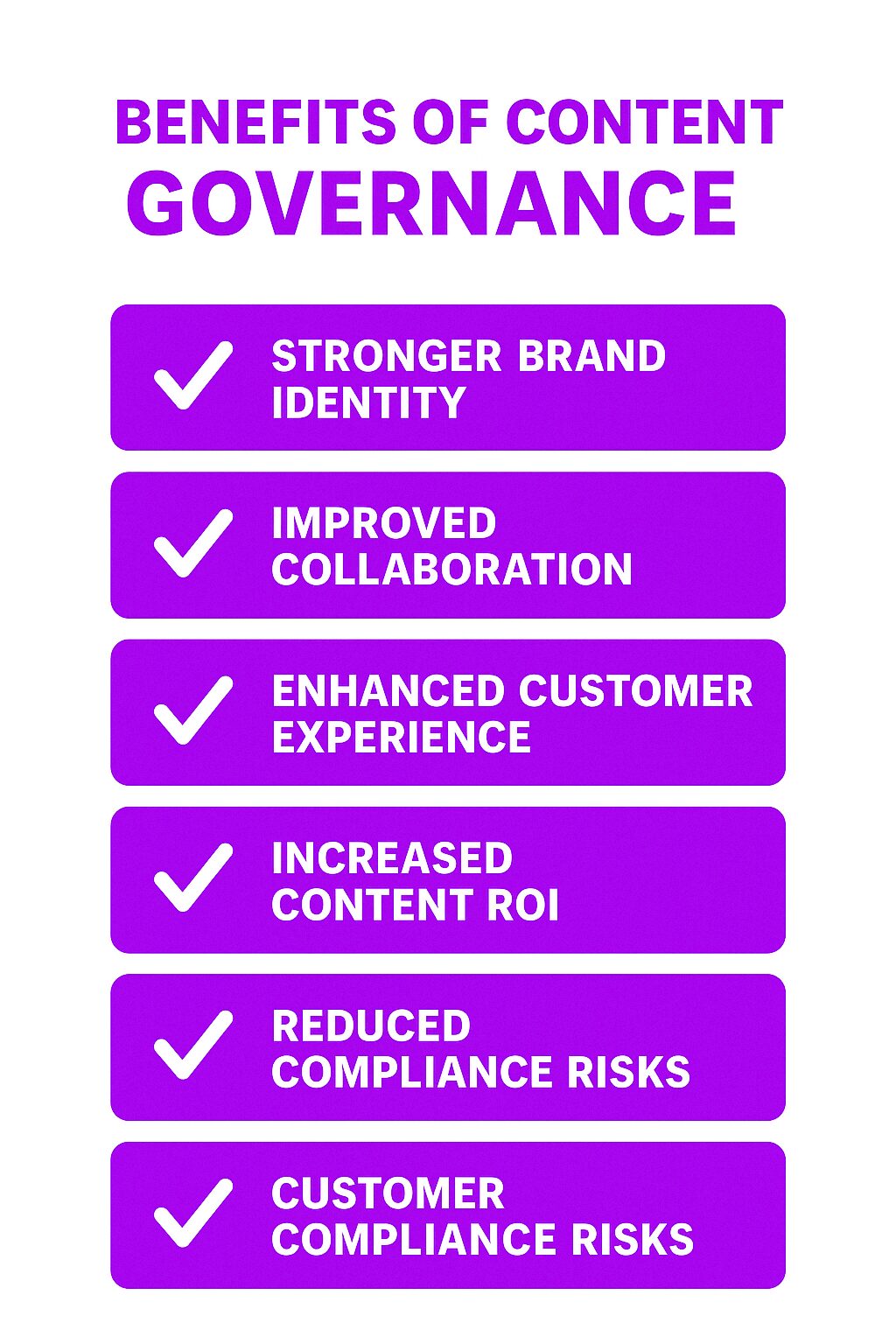What Is Content Governance?
Content governance is the system organizations use to manage, standardize, and control digital content across various platforms. Integrating a company’s content strategy into content governance is crucial as it captures and digitizes the current content status, guides content creation towards achieving goals, and enhances overall performance through actionable processes and metrics. It includes policies, workflows, and guidelines that ensure content is accurate, consistent, compliant, and aligned with business objectives. Companies use content governance to establish accountability, maintain brand identity, and mitigate risks associated with misinformation, outdated content, or non-compliance.
Content governance applies to all types of content, including website pages, blog posts, internal documents, marketing materials, and customer communications. Without a structured governance framework, content can become inconsistent, irrelevant, or legally risky.
Why Content Governance Matters
Content is an organization’s most valuable asset. It informs customers, educates employees, and influences brand perception. A well-defined content governance strategy helps companies maintain control over their messaging and ensure that their content meets business needs.
1. Ensures Consistency
Without governance, organizations risk publishing conflicting or outdated information. Consistent content ensures a uniform brand voice across all channels and is crucial for maintaining customer relationships.
2. Enhances Content Quality
Governance ensures that content meets quality standards, is free of errors, and aligns with the organization’s objectives.
3. Supports Compliance
Companies must comply with industry regulations, accessibility requirements, and legal standards. Governance minimizes the risk of content violations.
4. Improves Efficiency
A structured governance framework streamlines content workflows, making it easier for teams to create, review, and publish content without bottlenecks.
5. Mitigates Risks
Content-related risks include misinformation, legal liabilities, and reputational damage. Governance ensures content remains accurate and appropriate.
Key Elements of Content Governance Framework
Organizations build content governance frameworks around the following components:
1. Defined Goals and Policies
Companies must outline clear objectives for their content governance strategy. This includes setting guidelines for tone, voice, branding, and compliance.
2. Roles and Responsibilities
A governance framework should assign content-related roles, such as:
-
Content Creators – Responsible for drafting and updating content.
-
Editors and Reviewers – Ensure content quality and accuracy.
-
Legal and Compliance Teams – Verify content adheres to industry regulations.
-
Marketing Teams – Align content with branding and audience expectations.
3. Content Creation and Approval Process
A structured workflow defines how the content creation process moves from ideation to publication, aligning with the overall content strategy. This includes:
-
Drafting content based on pre-defined templates.
-
Submitting content for review and approval as part of the content approval process, which helps in managing tasks like identifying subject matter experts and adhering to brand guidelines.
-
Updating content when necessary.
4. Content Inventory and Auditing
Organizations must track and evaluate existing content. Ensuring that published content aligns with organizational goals and undergoes thorough review processes is crucial. A content audit helps identify outdated, underperforming, or redundant content.
5. Content Lifecycle Management
Content governance defines the lifecycle of digital content. Establishing a content governance framework is crucial for managing this lifecycle effectively:
-
Creation – Developing new content that meets brand standards.
-
Approval – Ensuring compliance with editorial and legal guidelines.
-
Publishing – Releasing content to its intended audience.
-
Updating – Reviewing and improving content as needed.
-
Archiving or Deletion – Retiring outdated content to maintain accuracy.
6. Performance Measurement
Governance should include metrics to track content effectiveness, including:
-
Engagement rates
-
Search engine rankings
-
Click-through rates
-
Compliance and risk assessment reports
A robust content governance process is crucial in managing content effectively post-publishing, ensuring sustainability, efficiency, and flexibility throughout the content lifecycle.
7. Compliance and Legal Guidelines
Industries like healthcare, finance, and government have strict content compliance requirements. A content governance model is crucial in ensuring compliance with industry regulations. Governance ensures content meets data privacy laws, accessibility guidelines, and industry regulations.
8. Training and Education
Governance frameworks should include employee training on content policies and best practices. This ensures teams understand their role in content management.
Benefits of Content Governance
1. Stronger Brand Identity
Governance maintains a consistent voice, style, and messaging across all platforms.
2. Improved Collaboration
Defined workflows make it easier for teams to collaborate on content creation, approvals, and updates. Having diverse content teams from various departments, such as HR, marketing, and sales, fosters cross-functional collaboration and ensures a more holistic approach to content creation.
3. Enhanced Customer Experience
Accurate, up-to-date content builds trust with customers and stakeholders. A structured content governance model can enhance the effectiveness and coherence of content marketing efforts, ensuring that all initiatives are aligned and well-organized.
4. Increased Content ROI
Governance ensures content remains relevant and valuable over time, reducing the need for redundant content creation.
5. Reduced Compliance Risks
Organizations avoid legal complications by ensuring content meets regulatory standards.
Challenges of Implementing Content Governance
1. Managing Large Content Volumes
Organizations with high content output may struggle to govern all materials effectively. Content management systems (CMS) play a crucial role in enhancing content governance and managing large volumes of content efficiently.
2. Aligning Multiple Teams
Different departments may have conflicting priorities, making governance difficult to enforce. Clearly defining roles and responsibilities within content processes is crucial to ensure effective collaboration.
3. Keeping Content Up-to-Date
Without regular audits, outdated content may remain published, affecting credibility.
4. Resistance to Change
Teams accustomed to decentralized content management may resist governance policies.
Best Practices for Content Governance
1. Establish Clear Guidelines
Document rules for content creation, branding, and compliance. Create editorial guidelines to establish consistency in content production.
2. Use a Centralized Content Management System (CMS)
A CMS allows organizations to store, organize, and track content efficiently. An effective content governance model requires a centralized CMS to maintain consistency and efficiency.
3. Automate Content Workflows
Automation tools help streamline content approvals, version control, and audits.
4. Conduct Regular Content Audits
Periodic reviews ensure content remains relevant, accurate, and compliant.
5. Assign Ownership and Accountability
Ensure each piece of content has a designated owner responsible for updates and accuracy.
6. Provide Ongoing Training
Educate employees on governance policies and content best practices.
Real-World Examples of Content Governance
1. Healthcare Industry
A hospital system enforces governance policies to ensure patient-facing content complies with HIPAA regulations and medical accuracy.
2. Financial Services
A bank maintains governance rules to prevent misleading marketing claims and ensure compliance with financial regulations.
3. E-commerce
An online retailer uses content governance to standardize product descriptions and prevent inconsistent messaging across global markets. Effective content governance ensures that social media posts, along with other forms of content, align with business objectives and maintain brand consistency, thereby enhancing overall customer experience.
The Future of Content Governance
As digital content expands, governance will become increasingly automated. AI-powered tools will assist with compliance monitoring, content personalization, and workflow management. Organizations that invest in structured governance frameworks will ensure content remains reliable, engaging, and aligned with business goals.







